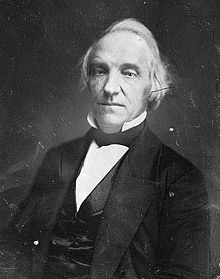Daniel S. Dickinson
Daniel S. Dickinson | |
|---|---|
 Dickinson, c. 1844–1860 | |
| 27th Attorney General of New York | |
| In office January 1, 1862 – December 31, 1863 | |
| Governor | Edwin D. Morgan Horatio Seymour |
| Preceded by | Charles G. Myers |
| Succeeded by | John Cochrane |
| United States Senator from New York | |
| In office November 30, 1844 – March 3, 1851 | |
| Preceded by | Nathaniel P. Tallmadge |
| Succeeded by | Hamilton Fish |
| Lieutenant Governor of New York | |
| In office January 1, 1843 – December 31, 1844 | |
| Governor | William C. Bouck |
| Preceded by | Luther Bradish |
| Succeeded by | Addison Gardiner |
| Member of the New York State Senate from the Sixth District | |
| In office January 1, 1837 – December 31, 1840 Serving with Various (multiple member district) | |
| Preceded by | John F. Hubbard, Ebenezer Mack, Levi Beardsley, George Huntington |
| Succeeded by | Laurens Hull, Alvah Hunt, Andrew B. Dickinson, Nehemiah Platt |
| Personal details | |
| Born | Daniel Stevens Dickinson September 11, 1800 Goshen, Connecticut, U.S. |
| Died | April 12, 1866 (aged 65) New York City, New York, U.S. |
| Resting place | Spring Forest Cemetery Binghamton, New York, U.S. |
| Political party | Democratic |
| Spouse |
Lydia Knapp (m. 1822) |
| Children | 4 |
| Relatives | Tracy Dickinson Mygatt (great-granddaughter) |
| Signature | |
Daniel Stevens Dickinson (September 11, 1800 – April 12, 1866) was an American politician and lawyer, most notable as a
Biography

Born in
He was a member of the
In 1844, he was appointed as a
He supported the Union during the
Dickinson was considered as a possible vice presidential candidate when Abraham Lincoln ran for reelection in 1864 and desired a pro-war Democrat on the Republican ticket to demonstrate support for his war policy, but the nomination went to Andrew Johnson. Dickinson supported Lincoln's reelection, and was appointed United States Attorney for the Southern District of New York in 1865, an office in which he served until his death.

On April 12, 1866, Dickinson died suddenly in New York City at the residence of his son-in-law Samuel G. Courtney, and was buried at the Spring Forest Cemetery in Binghamton. His cause of death was reported as a hernia.[5][6]
Legacy

Daniel S. Dickinson is the namesake of the village of Port Dickinson, New York (and the encompassing town), Dickinson County, Iowa, and Dickinson County, Kansas.[7] Dickinson street in Binghamton is named after Dickinson.[8] A bronze statue of Dickinson by Allen George Newman was erected in front of the Broome County Courthouse in Binghamton, New York in 1924.[9]
His great-granddaughter Tracy Dickinson Mygatt was a Socialist playwright and pacifist.[10]
Notes
- ^ "Litchfield Ledger - Student". ledger.litchfieldhistoricalsociety.org. Retrieved January 30, 2022.
- ^ "New Oxford Review". newoxfordreview.org.
- ^ Smith, Gerald (November 1, 2020). "Spanning Time: Daniel Dickinson, Galusha Grow were influential Civil War politicians". Press & Sun-Bulletin. Retrieved January 31, 2022.
- ^ Poore, Ben. Perley, Perley's Reminiscences of Sixty Years in the National Metropolis, Vol.1, pp.413-414 (1886).
- ^ "Bioguide Search". congress.gov. Retrieved January 30, 2022.
- nytimes.com.
- ^ Gannett, Henry (1905). The Origin of Certain Place Names in the United States. Govt. Print. Off. pp. 106.
- ^ "Daniel S. Dickinson, (sculpture)". Art Inventories Catalog. The Smithsonian American Art Museum. Retrieved September 12, 2020.
References
- United States Congress. "Daniel S. Dickinson (id: D000317)". Biographical Directory of the United States Congress. Retrieved on 2009-04-07
- Mr. Lincoln and New York: Daniel S. Dickinson Archived August 25, 2005, at the Wayback Machine
- Obit in NYT on April 14, 1866 (with a few incorrect dates)
- List of New York Attorneys General, at Office of the NYSAG
Further reading
- Speiser, Matt. “The Ticket’s Other Half: How and Why Andrew Johnson Received the 1864 Vice Presidential Nomination.” Tennessee Historical Quarterly 65, no. 1 (2006): 42–69. online.
External links
- Works by or about Daniel S. Dickinson at Internet Archive
- Daniel S. Dickinson Papers at the Newberry Library
- Daniel S. Dickinson Papers, Binghamton University Libraries
- Daniel S. Dickinson Digital Collection, Binghamton University Libraries

